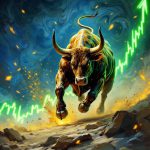What Is the Stock Market Outlook for 2025? The Fortune Cookie Might Know
April 04, 2025
The Brutal Truth: Why Most Traders Deserve to Lose
Let’s be clear—the market doesn’t care about your dreams. It doesn’t owe you clarity, consistency, or profit. Most traders lose not because markets are rigged but because they bring a broken psyche to a game of probabilistic warfare. They chase simplicity in a complex system, crave linear answers in a non-linear world, and react like lab rats to flashing lights.
Think of markets as vector fields—not point A to point B but multi-dimensional landscapes shaped by hidden variables, feedback loops, and emergent behavior. Yet most traders still cling to Newtonian cause-effect models in a quantum world. They treat volatility like a glitch, not a feature. And they overestimate their edge because they read two books on candlestick patterns and watched a YouTube guru yell about Fibonacci retracements.
Welcome to the Casino: The Crowd Always Loses
The crowd doesn’t think—it reacts. Masses chase hype, bail on dips, and pile in on news without questioning who benefits from the narrative. Their timeframes are microscopic, and their expectations are delusional. They want gains now, but learning is too slow, too painful. So they burn capital and repeat.
If you want to last, stop thinking like a pedestrian. Start thinking in layers—timeframes nested inside timeframes, like Russian dolls. Start thinking associatively—link tech sector momentum to lithium demand to South American mining instability. Let contradictions coexist: a stock can be overvalued and a buy. The economy can slow while the market rallies. Fundamentals matter—until they don’t. What matters more is understanding when the narrative flips.
This brings us to the core failure of most traders: they don’t adapt. They cling to models that no longer work. They chase momentum too late. They freeze during crashes. And they mock contrarians—until those contrarians cash out and disappear into the sunset.
The Fed’s endgame won’t be gentle. The next shock is already taking shape. Maybe it’s geopolitical. Perhaps it’s debt. Maybe it’s the unraveling of tech valuations. Whatever it is, it will clear the board. And what follows will be the most furious rally of the decade.
But only for those left standing.
Signals in the Noise: Know When the Room Turns
Look around. The Santa Claus rally pushed the Dow to record highs, but sentiment already whispers caution. AI stocks explode, and euphoria blinds even seasoned investors. NVDA rockets 25% in a week. META adds $200 billion in a single day. That’s not normal. It’s a signal.
This isn’t about avoiding hype. It’s about reading the room before it turns on you. When bullish sentiment soars past 56 and stays there, trouble brews. That’s when smart money quietly exits while retail cheers louder. Let them cheer. Your job is to be early on the exit, not the applause.
Don’t ignore the money on the sidelines. Over $6 trillion sits in money markets, paralyzed by fear and indecision. FOMO will ignite that fuse, pushing equity markets higher before they all collapse inward under their weight. Until then, play the game, but play it cold. Detach. Adapt.
Fed Theater and the Illusion of Control
Look at the Fed. Its policies are less about curbing inflation and preserving the illusion of control. Powell postures hawkish, but his toolkit is limited. Rate hikes continue to stress valuations while political pressure mounts to stimulate. The illusion holds—for now. But markets don’t pivot because of a single rate cut or jobs report. They pivot when belief erodes. That erosion is starting.
In this climate, sharp pullbacks are inevitable. Panic will spike. Weak hands will fold. Good. Let it happen. That’s your cue. Sharp corrections are the entry points. Don’t just survive them—salivate when they come. The masses sell during storms. You accumulate.
Cycles, Signals, and the Power of Rotation
Energy and commodities are already signaling regime shifts. Copper, steel, even OXY—the stuff the crowd ignores until it’s doubled. Buffett isn’t just holding OXY because he likes dividends. He sees the bigger arc. Think in sectors. Think in cycles. Think about the political and fiscal conditions feeding the next wave.
The SPX closed out 2023 with a 24.2% gain. Tech led, but the concentration is dangerous. The “Magnificent Seven” carried the index, but breadth remains weak. When these leaders falter, the illusion of market strength goes with them. That’s where the rotation begins—toward value, cyclicals, and ignored assets. Get ahead of that rotation.
Quantum Market Dynamics: Superposition, Entanglement, and Phase Shifts
Corrections aren’t risks—they’re resets. Reboots. Places where the system pauses, stutters, and reorganizes. To navigate them, you need to think outside of clean narratives and see the market like a living quantum system.
Quantum superposition teaches us this: Contradictory truths can coexist. A stock can be overvalued and still rip 30%. The economy can flash recession while the market rallies. What matters isn’t which signal is “right”—it’s which one the crowd believes long enough for the price to reflect it. Every tick is a probabilistic collapse—an outcome from infinite possible interpretations.
Now, layer in entanglement: the idea that distant elements, once connected, can remain linked across time and space. That’s the bond between rate hikes in the U.S. and liquidity crunches in emerging markets, between an obscure Chinese steel mill shutdown and price spikes in Western construction stocks. You cannot view assets in isolation anymore. Markets are entangled systems—move one piece and another twitches halfway across the board.
Then there’s phase transition—the sudden shift when conditions hit a critical threshold. Water freezes. Metal becomes magnetic. And in markets? Bull turns to bear. Euphoria flips to panic. The change isn’t always gradual—it’s often violent, systemic, and irreversible in the short term. The key is spotting the conditions, not the event. The boiling point matters more than the first bubble.
To thrive, you need to recognize the market not as a series of trends but as a system constantly nearing or crossing invisible boundaries. Sentiment, liquidity, positioning—these are your thermodynamic variables. Ignore them; you’re left holding the ice when everyone else rides the steam.
Final Word: Wake Up or Get Wiped Out
This isn’t just about markets. It’s about mindset. Most traders lose because they follow rules designed to enslave them emotionally, intellectually, and financially. They treat the market like a slot machine, not a sentient ecosystem.
Want to survive? Ditch binary thinking. Embrace paradox. Think in vectors. Learn from physics, art, psychology, history—because markets are fractal. They’re layered, self-referential, and constantly evolving.
You can’t win with the crowd. You win by outthinking it, outwaiting it, and outlasting it.
And if that’s too much work?
Then, yes, you deserve to lose.















